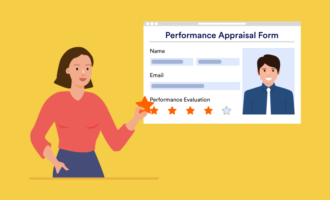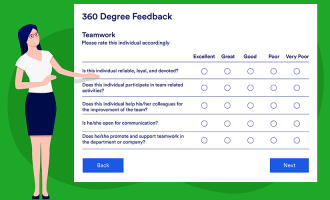Top methods of performance appraisal
- Goal setting: Goal setting involves defining specific objectives for employees to achieve. Managers then use these goals to assess employees’ performance.
- Feedback from colleagues: Feedback from colleagues is constructive input from coworkers to improve performance and professional growth.
- Employee self-assessment: Employee self-assessment is the process of employees evaluating their own performance, skills, and achievements in the workplace to gain insights, set goals, and contribute to their personal and professional development.
- Manager assessment: Manager assessment is an evaluation conducted by supervisors to assess employee performance and contributions.
- Discussion: Discussion includes direct, face-to-face interactions between an employee and manager to provide feedback, discuss performance, set goals, and address any relevant matters related to an employee’s performance assessment.
Performance evaluations can be pretty polarizing. Some employees love getting feedback, seeing it as a tool to help them grow and be more efficient at their job. Others may feel a lot of anxiety about someone critiquing their performance. And then there’s everyone in between, including some who may just want to get the process over with as quickly as possible.
So how do you create a performance evaluation process that works for the myriad different employees you encounter? Here’s the short answer: It’s easier with a solid plan and the right tools.
In this post, we’ll go over what a performance evaluation is, what you can achieve by conducting an evaluation, and how to set up the best process for your company.
What’s a performance evaluation?
Let’s start with the basics: What is a performance evaluation, and what are you trying to achieve by creating a performance evaluation process?
A performance evaluation, also called a performance appraisal, is the process of assessing your employees’ success at their jobs. Organizations often use these evaluations to determine whether a person is fit for a promotion or raise. Appraisals can also be a tool to provide feedback to employees that lets them know how they can improve their performance.
Some companies use performance evaluations to determine which employees they might lay off or put on a performance improvement plan (PIP). This can make the performance evaluation process rather stressful for employees.
Gallup reports that only 14 percent of employees feel motivated by their performance management system, and even worse, 95 percent of managers aren’t happy with it, either. It’s clear that most companies could benefit from taking a hard look at their current process and making a better plan.
Pro Tip
Establish a professional employee evaluation process with Jotform’s HR forms — no coding required.
What’s included in the performance evaluation process?
While the process may differ from one organization to the next, here are some typical aspects of the performance evaluation process.
Goal setting
The first stage of any evaluation process is setting up the standards supervisors will use to grade team members. This usually happens with some form of goal setting, most often determined by the head of the department, the head of the company, or a combination of both. It’s common for an employee to have goals that are based on a hybrid of company goals and department goals.
Feedback from colleagues
Once you’re nearing the end of your assessment period, you should encourage employees to gather feedback from others. The best way for them to do this is by reaching out to their closest teammates and asking for an honest evaluation of their work.
They can request this feedback from multiple people and collect it anonymously, if that’s what they prefer. An easy way to do this is through an online feedback request form.
Employee self-assessment
The performance evaluation process usually involves each employee completing a self-assessment. This is when they have a chance to look back on all of their accomplishments and grade them based on predetermined goals. A self evaluation form is helpful for collecting the employee’s assessment and passing it along to a manager for review.
Manager’s assessment
A manager can complete an assessment of a team member either before or after they’ve had a chance to review the employee’s self-assessment. Reviewing it in advance can help remind the manager of the employee’s accomplishments, but it may also sway their judgment.
The manager’s assessment is just the first step for a supervisor to deliver feedback — but an in-person review is the best way to go over that feedback.
Discussion
The final stage of the performance evaluation process usually involves a one-on-one discussion between the employee and their manager. This usually happens in an in-person meeting, and it involves going through each goal that the employee and manager set and evaluating whether the employee met or exceeded it. This is also the time to review the employee’s self-assessment and give the manager an opportunity to comment on it.
If performance evaluations are tied to compensation or bonuses, the manager can broach this subject with the employee now. This can also be the time to set up a performance improvement plan if the employee didn’t achieve their goals.
What are the benefits of conducting performance evaluations?
The benefits of performance evaluations are numerous, as long as you’re following the steps for a helpful and efficient process. Some benefits include
- Maintaining clear expectations and standards for employees
- Creating a direct path for promotions and raises
- Giving employees essential feedback to help them improve or feel valued
- Giving managers a chance to put employees who are struggling on a performance improvement plan
- Setting company-wide goals for all employees to work toward
How to create a performance evaluation process
As mentioned earlier, you can create the right performance evaluation process when you use the right tools. Here’s where Jotform comes in.
Jotform allows your HR department to create unique forms that work well for both employee self-assessments and manager-conducted evaluations. You can even use a form to get your employees’ coworkers to weigh in on their performance.
Here’s a simple, step-by-step guide on how Jotform can be an ideal solution for your performance evaluation process.
1. Create your forms
To collect the feedback you need for each employee, you’ll need a form with questions that address all of the performance areas you want to cover. You might find some inspiration from existing employee evaluation templates, or you can create your own. You may also want to create forms to collect feedback from other employees as well.
2. Automate feedback collection
Once you’ve created your forms, it’s time to email them to your employees and start collecting the feedback. You won’t have to do anything in the meantime, as your Jotform account will collect the responses and store all of your data in the cloud. You’ll be able to access it from anywhere.
3. Set up approvals
If your performance evaluation process requires approvals, Jotform has an easy solution. Just use the performance appraisal approval process template.
When an employee submits an evaluation form, an instant notification will go to the right manager. Once the manager completes their part of the process, the evaluation will automatically go to any other appropriate parties. When the process is complete, the original submitter will receive an automated confirmation email.
You can customize the approval flow to work best for your company, all in a few clicks. With Jotform’s no-code software, you can drag and drop approvers, create new conditions and branches, and even customize your automated emails.
4. Manage your data
With Jotform Tables, you can manage all of your data in an easy-to-use workspace. It allows you to sort your data, add tags and colors, import any existing data you may want to add, and share it with other colleagues. This can be helpful for sharing an employee’s performance with additional managers or with HR when it comes time to determine bonuses and compensation increases.
5. Hold your performance evaluation discussion
Once you’ve collected all the necessary information, the only thing left is to have your employees and their managers get together for the official reviews. Though it may feel stressful, having the proper system in place and clear expectations for everyone involved will make the process as smooth as possible.
After all, the performance evaluation process is essential for getting your work done efficiently, and it should be top of mind for companies that want to continue to grow and nurture their employees’ careers.
















































































Send Comment:
1 Comments:
More than a year ago
Very informative blog. In an employee performance review, managers evaluate that individual's overall performance, identify their strengths and weaknesses, offer feedback, and help them set goals. Employees typically have the opportunity to ask questions and share feedback with their manager as well.